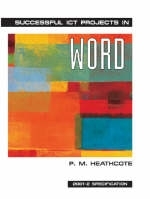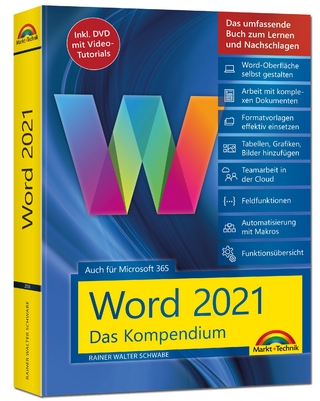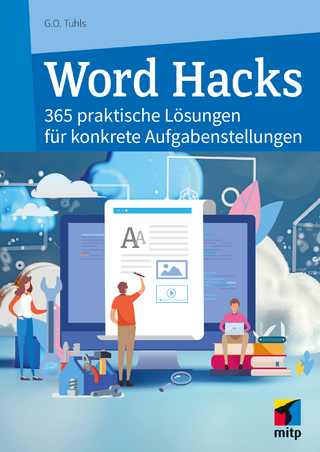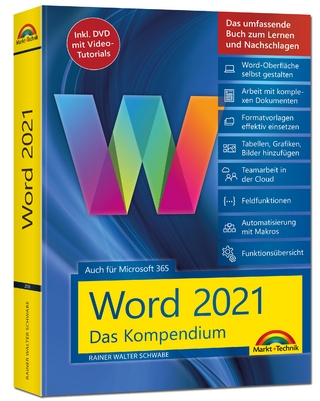
Successful ICT Projects In Word (2nd Edition)
Payne-Gallway Publishers (Verlag)
978-1-903112-25-0 (ISBN)
- Titel ist leider vergriffen;
keine Neuauflage - Artikel merken
A guide to writing 'A' level / BTEC / GNVQ projects using Microsoft Wo rd (version 6, 7, 97, 2000), covering analysis, design, and implementation using advanced features of Word.
Pat Heathcote has worked as a programmer and systems analyst, and has many years of experience in teaching Computing and Information Technology. She has served as an Assistant Examiner with AQA, is on the Subject Committee for Computing and is Chair of Examiners for Edexcel AVCE and GNVQ. She is now a full-time author and publisher.
Chapter 1 - Getting Started: Introduction; What level are you at?; Loading Word; The Word screen; Opening a new document, entering text and saving it; Closing, opening and print previewing a document; Fonts and point size; Selecting text; Spell-checking; Cutting, copying, pasting and undoing; Other buttons on the toolbar; Navigating around a document; The Edit menu. Chapter 2 - Styles and Formatting: The Formatting toolbar; Using styles; Creating your own styles; Changing an existing style; Changing styles from the Format menu Error!; Bookmark not defined.; Putting text into columns; Drop caps; Small caps; The Format painter. Chapter 3 - Tabs, Indents, Bullets and Boxes: Tabs; Altering the default tabs; Borders and shading; Changing indents; Hanging indents; Inserting symbols; Inserting a table; Bullets and numbering; Numbered lists; Checking Grammar. Chapter 4 - Graphics and Gridlines: Inserting artwork; Positioning graphics in Word 2000; Positioning graphics in Word 6, 7 or 97; Creating a watermark (Word 2000 and 97 only); Taking screenshots; Cropping a graphic; The Drawing toolbar (Word 2000 and 97); The Drawing toolbar (Word 6 and 7. Chapter 5 - Headers and Footers: Working on a network with restricted access; Creating your own template; Opening a new document based on the new template; Inserting a header or footer; Use WordArt to insert a heading; Inserting a text box; Inserting clip art; Working on the footer. Chapter 6 -Templates: What is a template?; Creating a template; Using the Contemporary Letter.dot template; Editing an existing template; Deleting autotext; Creating a new text style; Saving and using your template; Using a template stored on the A: drive; Inserting a date field; Adding a greeting, subject matter line,; main body and closing; Summary of templates hierarchy; Attaching a different template to an active; document. Chapter 7 - Macros: What is a macro?; Recording a macro; Running a macro; Assigning a macro to a key combination; Editing a macro; Creating an empty macro; Inserting the MacroButton field; Using the Organiser to copy macros. Chapter 8 - Tables, Formulae and; Forms: Introduction to invoicing; Using the master template; Inserting a table and adjusting row height; Merging cells and splitting the table; Styles and borders; Selecting cells, rows and columns; Inserting a default date; Inserting extra rows; Changing the alignment of text in each cell; Test data; Autocorrecting text; Entering formulae; Saving the invoice as a template; Adding a button to update fields; The manual processes involved; Using Word to create a form; The Forms toolbar; Adding numeric and calculated fields; Protecting the form and entering data; Entering a conditional field; Copying fields to other areas of the form; Saving the template and using it; Revisiting the Invoice. Chapter 9 - Mail Merge: What is mail merge?; Creating a data source; Entering test data; Creating the form letter; Merging the data with the letter; Setting merge conditions; Setting a 'flag'; Setting the query options; Displaying and editing field codes; Prompts to enter text; Editing the data source; Internal and external data sources. Chapter 10 - Customising Menus and Toolbars: Introduction; Creating the customised templates; Adding a custom menu; Creating a toolbar. Chapter 11 - Designing the User Interface: ; Designing the front end; How will the user access the menu?; Preparing the ground; Starting Visual Basic for Applications; Inserting a form for the menu; Adding text to the form; Adding a graphic; Placing a command button; Adding code to the command button; Adding a button to close the form; Adding code to the Mail Merge button; Adding code to the Close Menu button; Opening the main menu; Writing a procedure to open the menu; Customising the toolbar; Adding code to the Exit Word button; Creating an AutoExec macro; Providing the user with on-line help; Creating the Help file; Inserting the hyperlink fields in the; invoice template; Adding command buttons to close Help; Making the text hidden. Chapter 12 - Headers and Footers: Working on a network with restricted access; Creating your own template; Using headers and footers; Inserting a header or footer; Inserting a heading; Inserting a clip art logo; Working on the footer. Chapter 13 -Templates: What is a template?; Creating a template; Using the Letter2.dot template; Editing an existing template; Creating a new text style; Saving your template; Using your template; Inserting a date field; Adding a greeting, subject matter line, main body and closing; Summary; Attaching a different template to an active document. Chapter 14 - Macros: What is a macro?; Recording a macro; Running a macro; Assigning a macro to a key combination; Editing a macro; Exiting Word; Where is the button available?; Using the Organiser to copy macros. Chapter 15 - Tables, Formulae and Forms: Introduction to invoicing; Using the master template; Inserting a table and adjusting row height; Borders; Merging cells and splitting the table; Selecting cells, rows and columns; Setting styles and individual cell borders; Inserting a default date; Inserting extra rows; Changing the alignment of text in each cell; Test data; Entering formulae; Saving the invoice as a template; Recording a macro to update fields; Adding a button to update fields; The manual processes involved; Using Word to create a form; The Forms toolbar; Adding numeric and calculated fields; Protecting the form and entering data; Entering a conditional field; Running a macro on entry or exit; Copying fields to other areas of the form; Saving the template and using it; Revisiting the Invoice. Chapter 16 - Mail Merge: What is mail merge?: Creating a data source; Entering test data; Creating the form letter; Merging the data with the letter; Setting merge conditions; Setting a 'flag'; Setting the query options; Displaying and editing field codes; Prompts to enter text; Prompting for a different value for each; member; Editing the data source; Internal and external data sources. Chapter 17 - Customising Menus and Toolbars: Introduction; Creating the customised templates; Adding a custom menu; Creating a toolbar. Chapter 18 - Adding a Front End; Creating an application; Creating macros that run automatically. Chapter 19 - Starting Your Project: Selecting a suitable project; Possible scenarios; The mark scheme; Creating an outline for your project; Reordering topics; Adding numbers to the headings; Turning the outline into a document; Adding a header and footer; Inserting a Table of Contents. Chapter 20 - Analysis and Design: A top-down approach; Performing the analysis; SPECIFICATION; Planning a schedule of activities; Tackling the design; Designing the user interface; Macros; Design of stationery; Master template; Mail merge; Test plan. Chapter 21 - Implementation and; Testing; How is the implementation assessed?; Results of testing; Technical manual; User Guide. Chapter 22 - Evaluation: Introduction; Writing the evaluation; And finally... APPENDIX. AQA PROJECT GUIDELINES. INDEX.
| Erscheint lt. Verlag | 15.2.2000 |
|---|---|
| Reihe/Serie | GCE ICT |
| Verlagsort | Harlow |
| Sprache | englisch |
| Maße | 215 x 275 mm |
| Gewicht | 513 g |
| Themenwelt | Informatik ► Office Programme ► Word |
| ISBN-10 | 1-903112-25-7 / 1903112257 |
| ISBN-13 | 978-1-903112-25-0 / 9781903112250 |
| Zustand | Neuware |
| Informationen gemäß Produktsicherheitsverordnung (GPSR) | |
| Haben Sie eine Frage zum Produkt? |
aus dem Bereich


